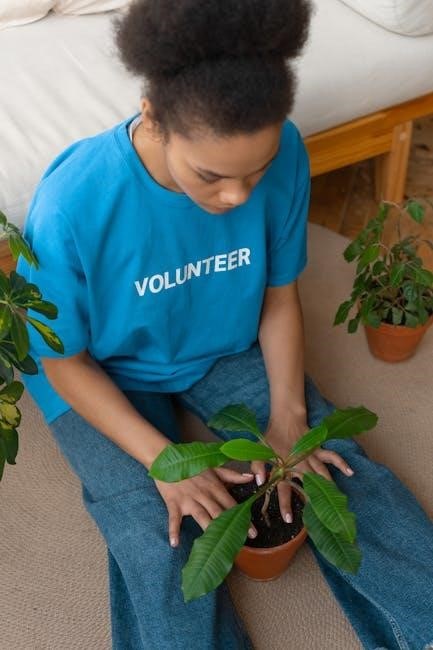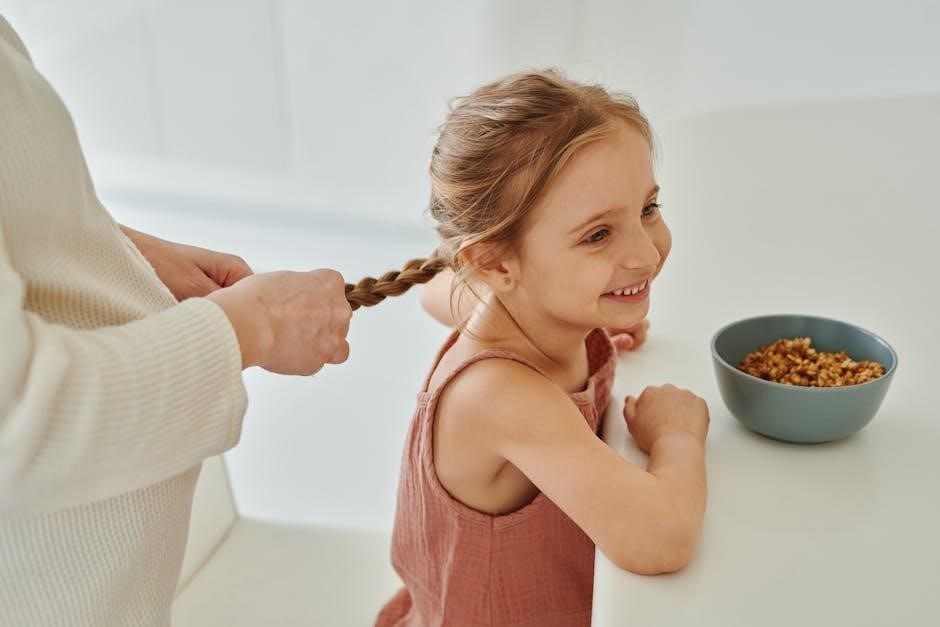Embark on an exciting journey of discovery! This guide offers a friendly, reassuring introduction to growing up. Explore the changes your body, mind, and emotions undergo. Get ready to embrace this adventure with confidence and knowledge!
What is Puberty? Understanding the Changes
Puberty is a natural process of physical and emotional development that transforms children into adults. It’s a unique journey with its own timeline, typically starting between ages 8 and 13 for girls. This exciting phase is triggered by hormones, acting as messengers that signal the body to change and mature. Think of it as your body’s way of preparing for adulthood!
During puberty, you’ll notice various changes happening within you. Understanding these changes is key to navigating this stage with confidence. From physical developments like breast growth and body hair to emotional shifts and mood swings, puberty is a time of significant transformation. Each girl experiences puberty differently, so embrace your individuality and remember that these changes are normal and natural. This guide is designed to help you understand and feel comfortable with these transformations, empowering you to navigate puberty with knowledge and self-assurance. You’re not alone on this journey!

Physical Changes During Puberty
Puberty brings many physical changes. This section covers breast development, body hair growth, and skin changes. Understanding these developments helps you navigate puberty with confidence. Embrace these transformations as a natural part of growing up!
Breast Development: What to Expect
Breast development is a key part of puberty. It typically starts between ages 8 and 13, but every girl’s timeline is unique. The first sign is often the appearance of “breast buds,” small, raised areas under the nipples. These may feel tender or sensitive.
Breasts grow in stages, and it’s normal for one breast to develop slightly ahead of the other. This difference usually evens out over time. As breasts grow, they’ll become more rounded and defined. You might notice changes in your nipples and areolas (the area around the nipple), which may become larger and darker.
Wearing a bra becomes necessary as breasts grow larger. A training bra or sports bra can provide support and comfort. Remember, breast size and shape vary greatly. There’s no “normal” breast, so embrace your unique body! If you have concerns, talk to a trusted adult or healthcare provider.
Body Hair: Growth and Management
The growth of body hair is a common and natural part of puberty. You’ll likely notice hair appearing in new places, such as your armpits and pubic area. This hair is typically thinner and lighter at first, gradually becoming thicker and darker.
The amount and distribution of body hair vary from person to person, influenced by genetics and ethnicity. There’s no “right” or “wrong” amount of body hair. It’s a matter of personal preference how you choose to manage it.
If you decide to remove body hair, several options are available. Shaving is a quick and painless method, but the hair grows back relatively quickly. Waxing and sugaring remove hair from the root, resulting in longer-lasting smoothness. Creams are available for removing hair. Always test a small area first.
Remember, hair removal is a personal choice. Do what makes you feel most comfortable and confident!
Skin Changes: Dealing with Acne and Body Odor
Puberty often brings changes to your skin, including acne and increased body odor. These changes are caused by hormones, so they are very normal! Acne occurs when pores become clogged with oil and dead skin cells, leading to pimples, blackheads, and whiteheads. Wash your face twice daily with a gentle cleanser.
Body odor develops as sweat glands become more active. These glands produce sweat that mixes with bacteria on your skin, causing an odor. Maintaining good hygiene is key to managing body odor. Shower or bathe daily with soap and water.
Use a deodorant or antiperspirant to help control sweat and odor; Deodorants mask the smell of body odor, while antiperspirants reduce sweat production. If you’re struggling with acne or body odor, talk to a dermatologist or doctor for personalized advice and treatment options.

Menstruation: A Comprehensive Guide
Welcome to a comprehensive guide about menstruation. This section provides essential information about the menstrual cycle. It will help you understand what to expect, manage your period, and maintain hygiene with confidence.
Understanding the Menstrual Cycle
The menstrual cycle is a natural process in a girl’s body, typically starting during puberty, usually between the ages of 8 and 14. It is a monthly series of changes that occur in the uterus and ovaries, preparing the body for potential pregnancy. The cycle is regulated by hormones, chemical messengers that control various bodily functions.
On average, a menstrual cycle lasts about 28 days, but it can range from 21 to 35 days, varying from person to person. The cycle begins on the first day of menstruation, also known as your period, when the uterine lining sheds. This shedding results in menstrual bleeding, lasting from 2 to 7 days.
After menstruation, the uterine lining thickens again in preparation for a fertilized egg. Ovulation occurs around the middle of the cycle, when an egg is released from one of the ovaries. If the egg is not fertilized, the uterine lining will eventually shed, and the cycle begins again. Understanding this process empowers you.
Preparing for Your First Period
Getting your first period is a significant milestone! It marks the start of menstruation, a natural part of growing up. Knowing what to expect can ease any anxiety. It usually begins between ages 8 and 14, so it’s wise to be prepared.
Start by stocking up on period supplies. Pads and tampons are common choices. Consider period underwear as an eco-friendly option. Keep a few supplies in your school bag or locker, so you’re always ready. Talk to a trusted adult, like your mom, older sister, or school nurse, about any questions or concerns. They can offer valuable advice and support.
Tracking your cycle is helpful. Use a period tracker app or a calendar to note the start and end dates of your periods. This helps you understand your cycle length and predict when your next period might arrive. Remember, every girl’s experience is unique, so try not to compare yourself to others. Be prepared and confident!
Managing Period Symptoms and Hygiene
Periods can bring a range of symptoms, but don’t worry! Many girls experience cramps, bloating, mood swings, and headaches. Over-the-counter pain relievers can help ease cramps and headaches. A warm bath or heating pad can also provide relief. Regular exercise and a healthy diet can minimize symptoms. Drink plenty of water to reduce bloating.
Maintaining good hygiene during your period is essential. Change your pad, tampon, or menstrual cup regularly, about every 4-8 hours, depending on your flow. Wash your genital area gently with mild soap and water. Avoid harsh soaps or douches, which can disrupt your natural balance. Keep a supply of hygiene products readily available. Consider carrying a small bag with wipes and a change of underwear for emergencies.
If you experience unusually heavy bleeding, severe pain, or other concerning symptoms, talk to your doctor. They can help you find the best ways to manage your period and ensure everything is healthy and normal. Remember, you are not alone, and help is available!

Emotional and Social Changes
Growing up involves emotional and social shifts. Understand mood swings, navigate friendships, and build self-esteem. Embrace your changing identity and learn healthy ways to cope with new feelings. Remember, it’s okay to ask for support!
Mood Swings and Emotional Regulation
Puberty brings a whirlwind of hormonal changes, often leading to mood swings. It’s completely normal to experience a range of emotions, from happiness to sadness, sometimes in quick succession. Understand that these shifts are largely due to hormonal fluctuations and not necessarily a reflection of who you are.
Learning emotional regulation is key. Develop healthy coping mechanisms such as exercise, journaling, or talking to a trusted adult. Identify your triggers – situations that tend to spark intense emotions – and create strategies for managing them. Practice mindfulness and relaxation techniques like deep breathing or meditation.
Remember, you’re not alone in this. Many girls experience similar emotional ups and downs during puberty. Be patient with yourself and allow yourself to feel your emotions without judgment. Seeking support from family, friends, or a counselor can provide valuable guidance and help you navigate these emotional changes with greater ease. Acknowledge your feelings and let them pass.
Body Image and Self-Esteem
Puberty brings significant changes to your body. It’s natural to feel self-conscious as your body transforms. Remember that everyone experiences these changes differently, and there’s no “right” way to look. Focus on appreciating your body for its strength and capabilities, rather than fixating on perceived flaws.
Self-esteem is closely linked to body image. Cultivate a positive self-image by focusing on your strengths, talents, and accomplishments. Challenge negative thoughts and replace them with positive affirmations. Surround yourself with supportive friends and family who appreciate you for who you are, inside and out.
Avoid comparing yourself to others, especially images on social media, which often portray unrealistic beauty standards. Embrace your unique qualities and celebrate your individuality. Remember that true beauty comes from within. Nurture your mind and spirit through activities you enjoy, and prioritize self-care. Build confidence by setting achievable goals and celebrating your successes along the way;

Healthy Habits for Growing Girls
Nurturing your well-being is essential during this transformative time. Discover the power of healthy habits! This section will provide practical tips for nourishing your body, staying active, and prioritizing mental wellness for a vibrant and balanced life.
Nutrition and Exercise for a Healthy Body
Fueling your body with the right nutrients is crucial. Embrace a balanced diet rich in fruits, vegetables, and whole grains. Prioritize protein for muscle growth and calcium for strong bones. Limit processed foods, sugary drinks, and excessive unhealthy fats. Experiment with healthy recipes and discover nutritious foods you enjoy.
Regular physical activity is essential for overall well-being. Find activities you love, whether it’s dancing, swimming, or team sports. Aim for at least 60 minutes of moderate-intensity exercise most days of the week. Exercise boosts energy, improves mood, and helps maintain a healthy weight.
Remember to stay hydrated by drinking plenty of water throughout the day. Listen to your body’s hunger cues and eat when you’re truly hungry. Avoid skipping meals, as this can lead to overeating later. Be mindful of portion sizes to maintain a healthy calorie intake.


